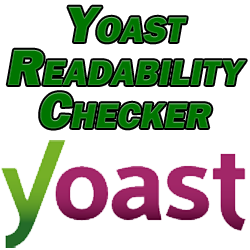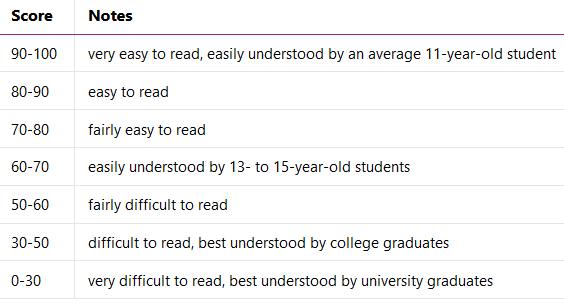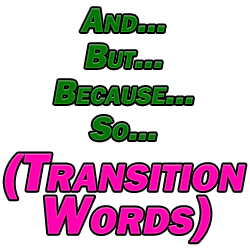The Yoast plugin is a freemium SEO plugin for WordPress run sites. Most webmasters understandably use it for its SEO recommendations, but the Yoast Readability checker is invaluable from a copywriting perspective.
The Yoast Readability checker analyzes your copy and makes sure that it’s easy to read. It gives you a score based on the readability of your content and advises changes accordingly.
Many webmasters ignore this aspect of the plugin, but it’s actually a great tool for training you to become a better writer.
Let’s look at each aspect of your copy the Yoast Readability checker takes into account and talk about why it’s so helpful for improving your copy.
Yoast Readability Checker
Flesch Reading Ease
First, we have arguably the most important metric: the Flesch reading ease score.
The Flesch reading ease portion focuses on the readability of your content as a whole, ensuring that it’s not overly wordy or awkward.
This gives you a real time copy score from 0-100. This chart from Yoast’s site shows how it works: The real purpose of the Yoast Readability checker is to make sure that it’s readable by the greatest audience.
The real purpose of the Yoast Readability checker is to make sure that it’s readable by the greatest audience.
This is exactly what we want for our content. I always say to write for your laziest reader, and the Flesch score ensures that you’re doing exactly that.
If your score falls below 60%, it will recommend writing more widely digestible sentences.
By that I mean shorter sentences with smaller words. Don’t write “gargantuan” when you can write “huge”.
Yes, we’re contributing to the sociological vocabulary shrinkage (it’s not going to like this sentence), but think about your business.
Leave the larger words to journalists and novelists; you’re trying to reach the greatest audience.
How to Raise Your Flesch Reading Ease Score
The easiest way to raise your Flesch reading ease score is to add in short sentences.
A sentence like this.
That sentence alone raised my score nearly 1%!
So did that one!
Anyway, I can do this all day.
Conversely, you can look for longer sentences which you can make two sentences out of.
That’s killing two birds with one stone.
Anyway.
Sentence Length
The sentence length aspect checks, you guessed it, the length of your sentences.
Specifically it will throw up a red flag if you have too many sentences over 20 words in length.
This feature of the Yoast Readability checker especially has had an impact on the way I write.
I look at the oldest posts I’ve written a decade ago and am shocked by how they meander on and on. Quite frankly, they’re hard to read.
I’ve very aware now when I write to keep my sentence length to a minimum.
What’s the Difference Between Flesch Reading Ease and Sentence Length?
An obvious question is what’s the difference between Flesch reading ease and sentence length elements in Yoast’s Readability checker? After all, they both check sentence length.
Sentence length focuses entirely on the number of words you’re using per sentence.
The Flesch reading ease gives a bit more nuance. You can have a sentence under 20 words, but if you’re using a lot of syllables in each word, the sentence can become bloated quickly.
So the Flesch reading ease score is more about the words you’re using, and if it could be more readable.
Use both of them together to make your content as widely readable as possible.
Paragraph Length
Next, we have the straightforward paragraph length.
When we (as readers) begin reading a huge paragraph filled with many sentences, it becomes more likely that we’ll lose our place or our minds will wander.
Each time a new paragraph begins, our brains get a subtle but much needed refresh. This increases the chances that we will internalize the information we’re reading.
As such, use a lot of short paragraphs to keep your reader’s mind focused on your content.
When it comes to paragraphs, I recommend limiting them to no more than two or three sentences each.
Basically every time I progress in what I’m talking about in the slightest, I begin a new paragraph.
It’s a good rule of thumb to follow. And if you’re not sure, go ahead and start a new paragraph.
Subheading Distribution
Somewhat similar to the paragraphs, effective subheading distribution keeps your content looking clean and organized.
Subheading distribution refers to using heading tags to break up your content.
It’s also important from an SEO standpoint as it’s designed specifically to demonstrate what your content is about.
Your main topic gets the most important heading tag, or H1.
Then you can use an H2 when talking about a subtopic of that H1. Use an H3 to begin talking about a subtopic of that H2 and so on.
Then you can start a new subtopic of the H1 with a new H2 and the process begins anew.
Use headings to organize and tag your content. It will help both your readers and search engines to understand your content.
Passive Voice
This aspect checks (and highlights) any sentences in which you’re using passive voice.
Let’s use the passive voice example from Yoast’s site: “I was hugged by mom.”
We can remove the passive from this example to convey the same thing with: “Mom hugged me.”
Passive voice is overly wordy and requires more cognitive working; two things we want to avoid with our content.
Our message should be clear and concise. This is why we want to avoid using passive voice.
You can click the “eye” icon to highlight any and all instances of passive voice in your writing to change them to an active voice.
Transition Words
Transition word examples are “and”, “but”, “so”, and “because”. 
They link sections of sentences and demonstrate the connections between concepts to your reader in your content.
If you’re not using enough transition words, this will let you know.
Consecutive Sentences
This is straightforward. If you begin three or more sentences with the same word, this will let you know. I appreciate this because I always get self conscious when I begin too many sentences with the word “I”.
In summary, the Yoast Readability checker is a great tool for being aware of your reader while writing.
Note that it only checks your copy itself.
There are other ways to make your content more digestible for your reader.
Break up your writing with images or offer your reader a video as an alternative way to consume your content.
As always, create content with your laziest visitors in mind and you’ll be in good shape.
